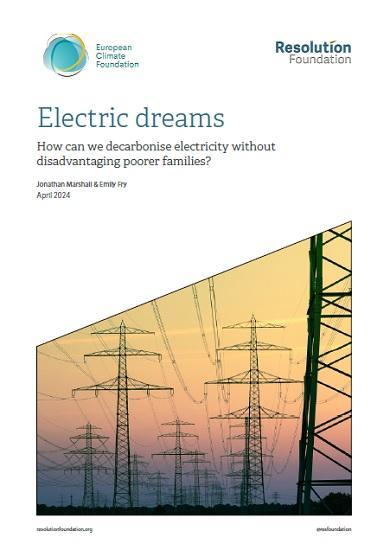Higher Interest Rates Could Add £29 Billion To Household Energy Bills So Britain Needs A Plan To Deliver An Energy Investment Surge That Protects Lower Income Households
23rd April 2024

Britain needs to increase investment in its power sector four-fold over the next decade to deliver the crucial next step in decarbonising the economy. But promises that electrifying our home heating and driving will lead to lower energy costs have relied on the pre-energy crisis low interest rates world returning, and we need a plan for paying for this investment in case interest rates stay at current high levels, according to new research published on Monday 22 April 2024 by the Resolution Foundation.
Electric Dreams considers how to fund the major power sector upgrade needed to cope with rising demand for electricity in a decarbonising economy. By 2040, Britain's homes will consume 45 per cent more electricity than in 2025, while road transport electricity demand will increase thirteen-fold, as heat pumps and Electric Vehicles (EVs) become commonplace.
The good news is that the costs, which are ultimately paid via household energy bills, of providing more renewable energy have fallen sharply over the past decade. For example, the cost of offshore wind contracts has fallen from £164 per megawatt hour in 2014, to just £51 in the 2022 renewable energy auction (in today's prices).
This, coupled with forecasts made when interest rates were at historic lows, have led many to say this investment surge can be delivered alongside consumer savings. The Foundation notes that in a low interest rates world, energy spending on people's homes and cars could fall by between 1 and 2 per cent of household income by 2050, compared to pre-pandemic levels, offering real terms savings of between £250 and £1,000 a year.
However, the authors note that historically low interest rates can no longer be banked on, and that the cost of financing energy investment if today's higher rates environment continues would be considerably more expensive, adding £29 billion a year to household energy bills in 2050.
For example, borrowing costs of nine per cent rather than five per cent would increase the cost of the same offshore wind project by 31 per cent, while households would see their future energy spending increase by an average of £400 in 2050, rather than decrease.
Worryingly, these higher energy prices would fall disproportionately on lower income households. The poorest fifth could see their total energy spending rise by £700 per year - or 3.6 per cent as a share of income - in this high cost world. Richer households would be less affected as the higher cost of domestic energy bills would be offset by savings from EV ownership, and their energy spending would rise by just 0.3 per cent.
While the future path of interest rates is highly uncertain, the Foundation says the government should plan for how it would deal with this higher interest rate environment. To do this, the report sets out three key areas for the government to focus on: pushing down on prices, price protection for low-to-middle income households, and balancing the financing of investment between household bills and the state.
First, the report says there should be a renewed focus on keeping prices low when delivering new investment. In the short term this means not overpaying for contracts today, but also making up lost ground on building the cheapest technologies - such as onshore wind - and preventing local politics around pylons and substations leading to higher cost alternatives.
Second, the government can mitigate against the risk of vulnerable households facing higher bills by introducing a social tariff for lower income families, protecting poorer households who are high energy users in particular.
Third, although publicly funding the entire power sector investment is not feasible, key aspects - such as modernising the grid - could be if the pressure of funding it all through energy bills becomes too great. The costs of tax, rather than energy bill, financed investment would be more evenly spread across the income distribution, rather than falling more heavily on poorer households.
Jonathan Marshall, Senior Economist at the Resolution Foundation, said:
"Britain needs to massively increase its electricity supply, and ensure it can be efficiently moved around the country, as we move towards a decarbonised economy of renewable energy, heat pumps and EVs.
"This will require tens of billions of pounds worth of investment each year - more over the next 15 years than insulating homes or buying electric cars. Cleaner energy could be cheaper energy, if interest rates return to the low levels seen during the 2010s.
"But we can't count on that being the case. If interest rates stay high, energy costs will rise rather than fall in the years ahead. So now is the time for planning on how we deliver the energy investment surge while protecting lower income households, with a greater focus on price reduction in contracts, price protection for vulnerable households, and rethinking the role of the state as an investor."
Key findings
Britain's electricity system is set to underpin the decarbonisation of the whole economy, but this means we must increase investment in the electricity system four-fold over the next decade.
But this investment is facing significant headwinds in the form of higher interest rates, with recent increases in the cost of borrowing pushing up the cost of building an offshore wind farm by 31 per cent.
As well as causing higher costs, rising interest rates increase uncertainty, leading to plausible future worlds where - at least for some households - spending on energy could be more than it is today.
Should this world come to pass, policy makers will need to intervene to protect the living standards of poorer families, and should do so by focussing on policies that deliver low cost energy, protecting households through a social tariff, or looking to taxpayers instead of billpayers to fund investment.
Read the full report HERE
Pdf 36 Pages.
